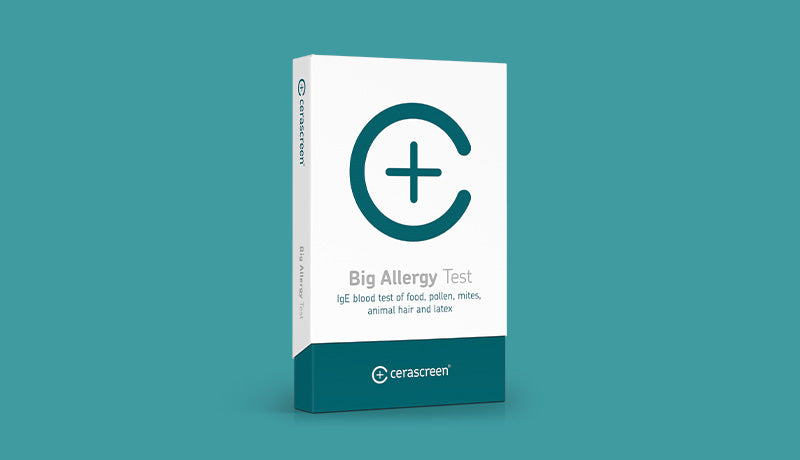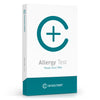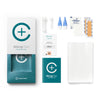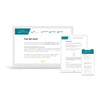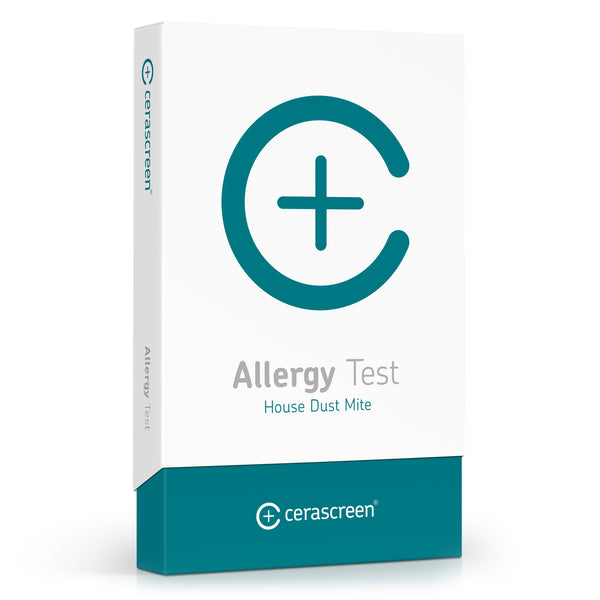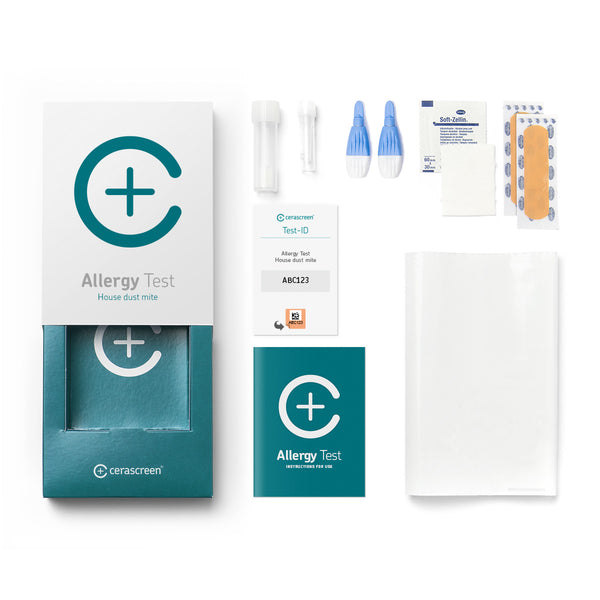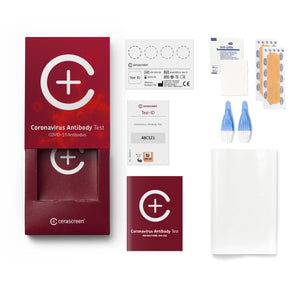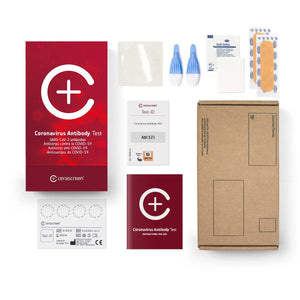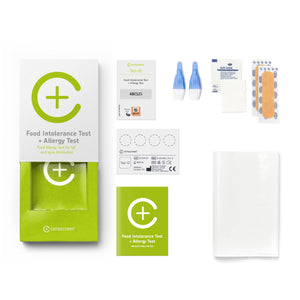product_id = 5085251665979variant_id = 34364583837755template_name =
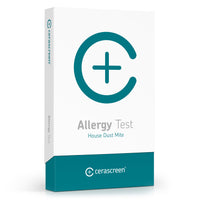
House Dust Mite Allergy Test
About the test
In a survey conducted in 2012, 23 of the allergy sufferers questioned stated that they were allergic to house dust. House dust allergy is common, and typical symptoms include a blocked nose, rhinitis and sneezing episodes as well as watery and itchy eyes.
With the cerascreen® House Dust Mite Allergy Test you can determine the number of specific IgE antibodies for dust mites in your blood. This tells you whether you are sensitised to dust mites and whether you may be allergic.
House Dust Mite Allergy Test
- Take your sample at home, with just one finger prick
- Receive a professional analysis from a medical laboratory
- Get a comprehensive results report
- Receive concrete recommendations on steps to take
- Receive your results within a few days after the sample’s arrival in the laboratory
Benefits of the House Dust Mite Allergy Test
Do you suffer from symptoms such as a sniffly nose, sneezing episodes and itchy eyes – especially in the morning? One cause could be a house dust allergy. A blood test will give you a useful indication of whether you could be allergic to house dust.
You can take your sample for the cerascreen® House Dust Mite Allergy Test discreetly and conveniently at home. The test is a blood test, which involves a small finger prick – the sample analysis then takes place in a specialised medical laboratory.
Benefit from our expertise: cerascreen® is the market leader for send-in home test kits in Europe, with eight years of experience in developing and analysing tests. We have developed more than 50 approved send-in test kits (medical devices), analyse around 150,000 samples annually and serve 20 countries.
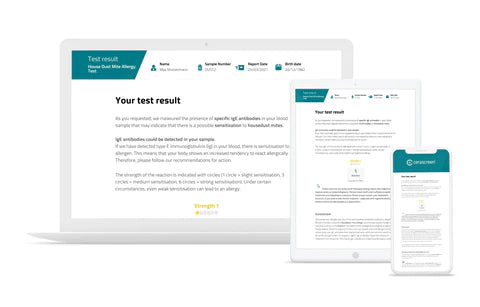
Result of the House Dust Mite Allergy Test
As soon as your sample has been analysed, you will be able to view your individual results report in the My cerascreen® mobile app or by logging in on our website, where you can also print the report. The laboratory analysis will tell you if you are sensitised to dust mite allergens. Learn what you can do if you have a house dust allergy with the help of our recommendations on steps you can take. We will also give you comprehensive health information explaining how a house dust allergy develops and what happens in the body.
Frequently asked questions about House Dust Mite Allergy Test
Why should I test for a house dust mite allergy?
House dust mites are found in every bed – without exception. Up to ten million of the tiny arachnids live in mattresses and bedding. The mites’ excrement gets into house dust particles and is dispersed into the air from there. Many people are allergic to these particles in the dust.
House dust allergy symptoms usually manifest themselves in the morning with a sniffly nose, itchy eyes and skin rashes. In the long run, this can turn into allergic asthma. That's why it’s important to recognise an allergy sooner rather than later and reduce exposure. An allergy test will help you gain answers to your symptoms. This certainty can be a sign for you to take action against the dust mites in your bedroom and thus relieve any symptoms.
How does the House Dust Mite Allergy Test work?
For the House Dust Mite Allergy Test, take a few drops of blood by pricking your fingertip with a lancet. Send the sample on a dried blood spot card by return envelope to our specialised laboratory free of charge. The laboratory will analyse your blood to see how high the number of IgE antibodies for house dust mites is.
What does the House Dust Mite Allergy Test tell me?
The results report will tell you if you are sensitised to dust mites and to what extent. If you are sensitised, this means that your immune system reacts defensively when it encounters allergens. These allergens can be, for example, certain proteins in the mites’ excrement. If you notice typical allergy symptoms in addition to a sensitivity, then it is very likely that you have a house dust allergy.
Which recommendations will I receive?
As with other allergies, the best treatment is to avoid the trigger. Of course, this is difficult when the culprit lives in your own bed. But the results report gives you a number of tips on how to make life difficult for the mites in your bedroom. Fewer dust mites usually means less discomfort.
You will also receive information specifically about immunotherapy (hyposensitisation). In this type of therapy, doctors repeatedly administer small amounts of an allergen over a period of several years. If the therapy works, your symptoms will go away. Specific immunotherapies are now also available for house dust allergies.
What happens if I have a house dust allergy?
If you have an allergy, the body’s defence reacts when your immune system comes into contact with these allergens. Allergens are proteins found, for example, in pollen, food, animal hair and dust mites. The immune reaction then leads to symptoms such as allergic rhinitis and itchy eyes.
With a house dust allergy, it is mainly the excrement of the house dust mites that trigger the reaction. This usually happens while we are in bed – because the mites prefer to live in bedding and mattresses.
What are the causes of a house dust allergy?
Researchers still do not know exactly how allergies develop. What is clear is that genetic predisposition plays a role. If your parents are allergy sufferers, then you also have a higher risk of developing a house dust allergy.
What are the symptoms of a house dust allergy?
A house dust allergy is primarily an inhalation allergy. This means that people suffering from this allergy inhale the allergens and then have symptoms in the upper and lower respiratory tract. Symptoms that appear on the skin are also possible, but rare.
The symptoms of house dust allergy generally are most severe in the morning after waking up. Typical symptoms are:
- stuffy nose and watery rhinitis with sneezing attacks
- itchy and watery eyes
- itchy and red skin
People with neurodermatitis may find that their condition flares up with a house dust allergy.
How do I treat a house dust allergy?
There are medicines that can suppress allergy symptoms. The most common are tablets with antihistamines. However, they are not suitable for long-term use – and are therefore not a good solution for house dust allergy sufferers, who are surrounded by the allergy triggers every night.
The recommendation for those with a house dust allergy is therefore to make sure that there are as few mites as possible in your bed. This can be achieved by keeping the bedroom as dry and cool as possible. This is because dust mites need a warm, humid climate. For example, it helps if you air the room frequently, remove plants and pets from the bedroom and regularly wash your bed linen at 60 degrees."
A house dust allergy can only really be treated with hyposensitisation (immunotherapy). Doctors administer the house dust allergen at regular intervals over a period of years. Treatment is not always successful. But if it is successful, your body gets used to the allergen and symptoms can improve significantly or even disappear.
For whom is the test not suitable?
The House Dust Mite Allergy Test is not suitable for or is only suitable to a limited extent for certain groups of people:
- People with infectious diseases, such as hepatitis and HIV, are not allowed to take the House Dust Mite Allergy Test.
- People with haemophilia should not take the blood test.
- Pregnant and breastfeeding women should only take the House Dust Mite Allergy Test under medical supervision. The reference values and recommendations do not apply to them either, so they should receive recommendations on the test result from a doctor.
- The House Dust Mite Allergy Test is not suitable for children under 18 years of age.
The test is not intended for diagnosing disease. For example, if you suffer from constant infections or a serious infectious disease, seek medical advice.
Why are children under 18 not allowed to take the test?
Our tests are not suitable for underage children and adolescents under the age of 18. Under 18s cannot activate the tests online and therefore cannot receive a test result. We ask that you do not administer the tests to your children either.
Children and adolescents need much closer supervision and counselling regarding medical tests and their interpretation. Testing with lancets and chemicals is not without risk and would need to be closely supervised by guardians. In addition, the reference values we give are always based on adult data. In the case of children, the risk of misinterpreting the results would be very high.
We want to fulfil our responsibility as a provider of medical products and ensure that children and adolescents are not unsettled by measurement results that are difficult for them to interpret. Since we cannot control whether the minors' legal guardians actually consent to the test being carried out and supervise them, we exclude tests for under 18s altogether.
If you are under 18 and have purchased a test, please contact our customer support.
Why does it take up to a week for the sample to reach the lab?
Please bear in mind that your results will not be analyzed in the UK but in Germany. For that reason, it can take up to a week for the sample to arrive at the lab. This does not affect the stability of the samples, as the method we are using is optimized for long transports.
Initially, your sample is sent to our collection center in the UK. From there, it is shipped to our central sample sorting facility in Germany, which then distributes samples to our partner laboratories. Once your sample is analyzed there, you will receive a notification and can access your result online.
Please check your mailbox regularly. We will notify you as soon as your sample is sent, arrives, or is analyzed.
This is how it works
1. Test at home
Your test kit contains everything you need to draw a small sample of blood from your fingertip. Then send the sample back to us free of charge in the enclosed return envelope.
2. View results online
After the evaluation in the medical specialist laboratory, you will have online access to your personal result report.
3. Act
Your access to the test results and the evidence-based findings and tips to improve your health: the my cerascreen® user profile on our website or our app.
